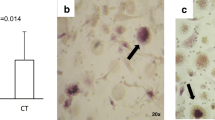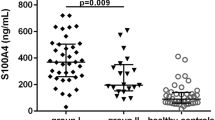Abstract
Ankylosing spondylitis (AS) is characterized by ankylosis of axial joints but osteoporosis is also a well-reported feature. T cells have been implicated as a source of receptor activator of NFκB ligand (RANKL) in inflammatory bone diseases. Hence, we assessed whether T cells in patients with AS act as a source of RANKL too. Therefore, we investigated the expression of RANKL on T cells from 21 patients with AS by flow cytometry. Bone mineral density (BMD) was evaluated by quantitative computer tomography (QCT) and dual X-ray absorptiometry (DXA) and correlated with serum levels of osteoprotegerin (OPG) and RANKL. BMD was decreased in 45% of all patients when measured with DXA (48% with QCT) and correlated negatively with OPG. Expression of intracellular RANKL was increased on CD4+ (84 vs. 70%) and CD8+ (85.2 vs. 65.3%, P < 0.05) T cells in patients with AS, whereas expression of membrane-bound RANKL was significantly lower (CD4+: 2.2 vs. 8.5% and CD8+: 0.7 vs. 3.2%, P < 0.01). Our results indicate that surface and intracellular RANKL production is differentially regulated on T cells of patients with AS.



Similar content being viewed by others
References
Toussirot E, Wendling D (2000) Bone mass in ankylosing spondylitis. Clin Exp Rheumatol 21:16–20
Wong BR, Rho J, Arron J, Robinson E, Orlinick J, Chao M, Kalachikov S, Cayani E, Bartlett FS 3rd, Frankel WN, Lee SY, Choi Y (1997) TRANCE is a novel ligand of the tumor necrosis factor receptor family that activates c-Jun N-terminal kinase in T-cells. J Biol Chem 272:25190–25194
Simonet WS, Lacey DL, Dunstan CR, Kelley M, Chang MS, Lüthy R, Nguyen HQ, Wooden S, Bennett L, Boone T, Shimamoto G, DeRose M, Elliott R, Colombero A, Tan HL, Trail G, Sullivan J, Davy E, Bucay N, Renshaw-Gegg L, Hughes TM, Hill D, Pattison W, Campbell P, Sander S, Van G, Tarpley J, Derby P, Lee R, Boyle WJ (1997) Osteoprotegerin: a novel secreted protein involved in the regulation of bone density. Cell 89:309–319
Lacey DL, Timms E, Tan HL, Kelley MJ, Dunstan CR, Burgess T, Elliott R, Colombero A, Elliott G, Scully S, Hsu H, Sullivan J, Hawkins N, Davy E, Capparelli C, Eli A, Qian YX, Kaufman S, Sarosi I, Shalhoub V, Senaldi G, Guo J, Delaney J, Boyle WJ (1998) Osteoprotegerin (OPG) ligand is a cytokine that regulates osteoclast differentiation and activation. Cell 93:165–176
Kong YY, Yoshida H, Sarosi I, Tan HL, Timms E, Capparelli C, Morony S, Oliveira-dos-Santos AJ, Van G, Itie A, Khoo W, Wakeham A, Dunstan CR, Lacey DL, Mak TW, Boyle WJ, Penninger JM (1999) OPGL is a key regulator of osteoclastogenesis, lymphocyte development and lymph-node organogenesis. Nature 397:315–323
Kong YY, Feige U, Sarosi I, Bolon B, Tafuri A, Morony S, Capparelli C, Li J, Elliott R, McCabe S, Wong T, Campagnuolo G, Moran E, Bogoch ER, Van G, Nguyen LT, Ohashi PS, Lacey DL, Fish E, Boyle WJ, Penninger JM (1999) Activated T-cells regulate bone loss and joint destruction in adjuvant arthritis through osteoprotegerin ligand. Nature 402:304–309
Kotake S, Udagawa N, Hakoda M, Mogi M, Yano K, Tsuda E, Takahashi K, Furuya T, Ishiyama S, Kim KJ, Saito S, Nishikawa T, Takahashi N, Togari A, Tomatsu T, Suda T, Kamatani N (2001) Activated human T cells directly induce osteoclastogenesis from human monocytes: possible role of T cells in bone destruction in rheumatoid arthritis patients. Arthritis Rheum 44:1003–1012
Schett G (2006) Rheumatoid arthritis: inflammation and bone loss. Wien Med Wochenschr 156:34–41
Kawai T, Matsuyama T, Hosokawa Y, Makihira S, Seki M, Karimbux NY, Goncalves RB, Valverde P, Dibart S, Li YP, Miranda LA, Ernst CW, Izumi Y, Taubman MA (2006) B and T lymphocytes are the primary sources of RANKL in the bone resorptive lesion of periodontal disease. Am J Pathol 169:987–997
Garrett S, Jenkinson T, Kennedy LG, Withelock H, Gaisford P, Calin A (1994) A new approach to defining disease status in ankylosing spondylitis: the Bath Ankylosing Spondylitis Disease Activity Index. J Rheumatol 21:2286–2291
Calin A, Garrett S, Whitelock H, Kennedy LG, O’Hea J, Mallorie P, Jenkinson T (1994) A new approach to defining functional ability in ankylosing spondylitis: the development of the Bath Ankylosing Spondylitis Functional Index. J Rheumatol 21:2281–2285
World Health Organization. Assessment of fracture risk, its application to screening for postmenopausal osteoporosis (1994) Report of a WHO Study Group. WHO Technical Report Series No. 843. WHO, Geneva, pp 1–129
Pietschmann P, Gollob E, Brosch S, Hahn P, Kudlacek S, Willheim M, Woloszczuk W, Peterlik M, Tragl KH (2003) The effect of age and gender on cytokine production by human peripheral blood mononuclear cells and markers of bone metabolism. Exp Gerontol 38:1119–1127
Karberg K, Zochling J, Sieper J, Felsenberg D, Braun J (2005) Bone loss is detected more frequently in patients with ankylosing spondylitis with syndesmophytes. J Rheumatol 32:1290–1298
Capaci K, Hepguler S, Argin M, Tas I (2003) Bone mineral density in mild and advanced ankylosing spondylitis. Yonsei Med J 44:379–384
Kudlacek S, Schneider B, Peterlik M, Leb G, Klaushofer K, Weber K, Woloszczuk W, Willvonseder R, Austrian Study Group on Normative Values of Bone Metabolism (2003) Normative data of bone mineral density in an unselected adult Austrian population. Eur J Clin Invest 33:332–339
Lee YS, Schlotzhauer T, Ott SM, van Vollenhoven RF, Hunter J, Shapiro J, Marcus R, McGuire JL (1997) Skeletal status of men with early and late ankylosing spondylitis. Am J Med 103:233–241
Reid DM, Nicoll JK, Kennedy NS, Smith MA, Tothill P, Nuki G (1986) Bone mass in ankylosing spondylitis. J Rheumatol 13:932–935
Khosla S, Arrighi HM, Melton LJ 3rd, Atkinson EJ, O’Fallon WM, Dunstan C, Riggs BL (2002) Correlates of osteoprotegerin levels in women and men. Osteoporos Int 13:394–399
Pulsatelli L, Dolzani P, Silvestri T, Caraceni P, Facchini A, Ravaglia G, Salvarani C, Melicòni R, Mariani E (2004) Soluble receptor activator of nuclear factor-κB ligand (sRANKL)/osteoprotegerin balance in ageing and age-associated diseases. Biogerontol 5:119–127
Kudlacek S, Schneider B, Woloszezuk W, Pietschmann P, Willvonseder R (2003) Serum levels of osteoprotegerin increase with age in a healthy adult population. Bone 32:681–686
Kim HR, Kim HY, Lee SH (2006) Elevated serum levels of soluble receptor activator of nuclear factors-KappaB ligand (sRANKL) and reduced bone mineral density in patients with ankylosing spondylitits (AS). J Rheumatol 45:1197–2000
Boyle LH, Goodall JC, Opat SS, Gaston JS (2001) The recognition of HLA-B27 by human CD4(+) T-lymphocytes. J Immunol 167:2619–2624
Zou J, Rudwaleit M, Brandt J, Thiel A, Braun J, Sieper J (2003) Down-regulation of the nonspecific and antigen-specific T cell cytokine response in ankylosing spondylitis during treatment with infliximab. Arthritis Rheum 48:780–790
Udagawa N, Kotake S, Kamatani N, Takahashi N, Suda T (2002) The molecular mechanism of osteoclastogenesis in rheumatoid arthritis. Arthritis Res 4:281–289
Miranda-Carús ME, Benito-Miguel M, Balsa A, Cobo-Ibáñez T, Pérez de Ayala C, Pascual-Salcedo D, Martín-Mola E (2006) Peripheral blood T lymphocytes from patients with early rheumatoid arthritis express RANKL and interleukin-15 on the cell surface and promote osteoclastogenesis in autologous monocytes. Arthritis Rheum 54(4):1151–1164
Schlondorff J, Lum L, Blobel CP (2001) Biochemical and pharmacological criteria define two shedding activities for TRANCE/OPGL that are distinct from the tumor necrosis factor alpha convertase. J Biol Chem 276:14665–14674
Hikita A, Yana I, Wakeyama H, Nakamura M, Kadono Y, Oshima Y, Nakamura K, Seiki M, Tanaka S (2006) Negative regulation of osteoclastogenesis by ectodomain shedding of receptor activator of NF-κB ligand. J Biol Chem 48:36846–36855
Lum L, Wong BR, Josien R, Becherer JD, Erdjument-Bromage H, Schlöndorff J, Tempst P, Choi Y, Blobel CP (1999) Evidence for a role of a tumor necrosis factor-alpha (TNF-alpha)-converting enzyme-like protease in shedding of TRANCE, a TNF family member involved in osteoclastogenesis and dendritic cell survival. J Biol Chem 7:13613–13618
Nakashima T, Kobayashi Y, Yamasaki S, Kawakami A, Eguchi K, Sasaki H, Sakai H (2000) Protein expression and functional difference of membrane-bound and soluble receptor activator of NF-kappaB ligand: modulation of the expression by osteotropic factors and cytokines. Biochem Biophys Res Commun 275:768–775
Acknowledgments
The authors are very grateful to all enrolled patients with ankylosing spondylitis, especially to Maria Nimführ, the president of the support group “Morbus Bechterew” in Vienna, for their dedication and participation in this study.
Author information
Authors and Affiliations
Corresponding author
Rights and permissions
About this article
Cite this article
Stupphann, D., Rauner, M., Krenbek, D. et al. Intracellular and surface RANKL are differentially regulated in patients with ankylosing spondylitis. Rheumatol Int 28, 987–993 (2008). https://doi.org/10.1007/s00296-008-0567-y
Received:
Accepted:
Published:
Issue Date:
DOI: https://doi.org/10.1007/s00296-008-0567-y




